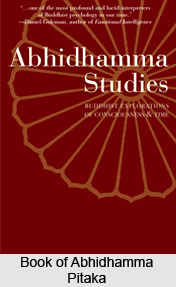 The abhidhamma pitaka consists of seven books, which are as follows:
The abhidhamma pitaka consists of seven books, which are as follows:
•Dhammasangani (-sangani or -sangana)
•Vibhanga (vibhanga)
•Dhatukatha (dhatukatha)
•Puggalapannatti (-pannatti)
•Kathavatthu (katha-)
•Yamaka
•Patthana (patthana)
Dhammasangani
This book begins with a matika (m?tik?, literally standing for, `matrix`), listing categorisations of dhammas, diversely translated as phenomena, ideas, states, etc. It begins with 22 threefold categorisations, starting with good/bad/unclassified, and succeeds this with 100 twofold ones, according to the abhidhamma method. Many of these categorisations though are not in-depth, and some are not even exclusive. The matika ends with 42 twofold categorisations according to the sutra method, which are used only in this book, while the other 122 are also used in some of the other books.
The main body of the book is divided into four parts. The first of these implements numerous states of mind, listing and defining, by lists of synonyms, factors present in them. The second is about material form, starting with its own matika, classifying by ones, twos and so on, explained later on. The third explains the book`s matika in terms of the first two parts, as does the fourth, by a different method, and excluding the sutra method.
Vibhanga
This book is divided into 18 chapters, each dealing with a different topic; for instance the first deals with the five aggregates. A characteristic chapter (there are a number of variances from this pattern) is divided into three parts. The first explains the topic according to the sutra method, frequently word-for-word, the same as in factual sutras. The second is abhidhamma explanation, principally by lists of synonyms as in the Dhammasangani. The third utilises questions and answers, based on the matika: "How many aggregates are good etc?"
Dhatukatha
This book covers both the matika and diverse topics, largely from the Vibhanga, pertaining them to the 5 aggregates, 12 bases and 18 elements. The first chapter is pretty simple: "In how many aggregates etc. are good dhammas etc. included?" The book increasingly works up to more complicated questions: "From how many aggregates etc. are the dhammas dissociated from attention etc.?"
Puggalapannatti
This book begins with its own matika, which starts with some standard lists, but then continues with lists of persons grouped numerically from ones to tens. This latter portion of the matika is then explained in the chief body of the work. Most of the lists of persons and many of the explanations are also found in the Anguttara Nikaya.
Kathavatthu
This book comprises more than two hundred debates on questions of doctrine. It does not name the participants. The commentary states the debates are between the Theravada and other schools, which it distinguishes in each case. These identifications are largely coherent with what is known from other sources about the doctrines of different schools.
Yamaka
This book comprises ten chapters, each dealing with a different topic; for instance, the first deals with roots. A characteristic chapter (there are a number of variances from this pattern) is divided into three parts. The first part deals with questions of identity: "Is good root root?" "But is root good root?" The whole Yamaka consists of such pairs of transposed questions, with their answers. Thus its name, which means pairs. The second part deals with arising: "For someone for whom the form aggregate arises, does the feeling aggregate arise?" The third part deals with understanding: "Does someone who understands the eye base understand the ear base?"
Patthana
This book deals with 24 conditions in relation to the matika: "Good dhamma is related to good dhamma by root condition", with particulars and numbers of answers.




















